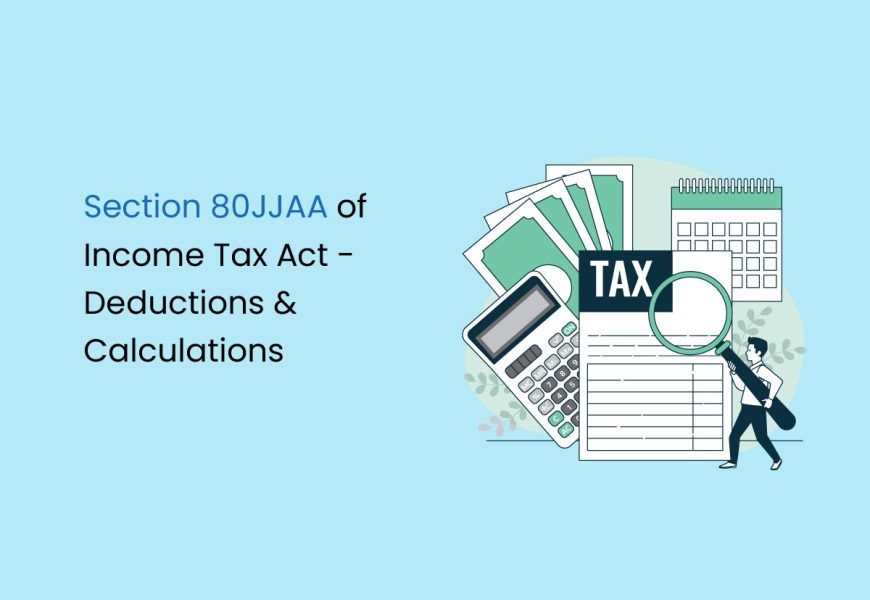Addressing the pervasive issue of unemployment is an important concern for any nation. In response to this challenge, a dedicated section called Section 80JJAA has been introduced to not only generate more employment opportunities but also to bolster motivation within the workforce.
Within the framework of the Income Tax Act of India, this section exists to provide various provisions aimed at facilitating tax deductions for both individuals and businesses. It is also commonly called the 80JJAA deduction. Delving into the specifics of this deduction is crucial for a comprehensive understanding, encompassing its applicability and the intricacies involved in its calculation.
In this article, we will explore the intricacies of the recruitment process that can be strategically employed to leverage substantial deductions in additional employee costs.
What is Section 80JJAA?
Section 80JJAA, a provision within the Indian Income Tax Act of 1961, stands as a pivotal instrument designed to facilitate tax deductions for employers actively contributing to employment generation within the formal sector. Specifically targeted at Income From Business, this deduction is applicable to assesses who have augmented their workforce by hiring additional employees in a given fiscal year. The crux of this provision lies in empowering employers to claim a deduction equivalent to 190% of the additional employee costs incurred in the process of hiring new, eligible employees.
The underlying purpose of Section 80JJAA is deeply rooted in the encouragement of employers to spearhead the creation of fresh employment opportunities within the formal sector. As an incentive mechanism, this provision extends tangible benefits to employers who, by virtue of hiring new personnel, contribute to the economic landscape. By offering a tax deduction, the government strategically aims to stimulate employers to expand their workforce, thereby actively mitigating the prevailing issue of unemployment in the country.
What is the Meaning of Additional Employees under Section 80JJAA?
Additional employees, as per Section 80JJAA, refer to individuals employed during the previous year. However, certain exclusions apply:
| Exclusions | Criteria |
|---|---|
| Total salary exceeding Rs. 25,000 per month | Employees not considered as additional employees |
| Employment for less than 240 days (150 days for specific sectors) | Employees are excluded if their tenure is less than the specified duration |
| Non-participation in Recognised Provident Fund | Employees not contributing to the Recognised Provident Fund, such as casual workers |
| Government-covered contribution under Employees’ Pension Scheme | Employees whose entire contribution is covered by the Government under the scheme |
What is Additional Employee Cost under Section 80JJAA?
Additional Employee Cost signifies the total emoluments paid or payable to additional employees.
| Criteria for Existing Business | Calculation of Additional Employee Cost |
|---|---|
| No increase in the total number of employees | Additional Employee Cost is NIL if the total number of joined equals the total number of departed employees during the previous year. |
| Example | In the given example, with no increase in the total number of employees, the deduction is not applicable. However, if the joined employees were 30, a deduction for the additional 10 employees would be available. |
What is the Meaning of Emoluments under Section 80JJAA?
Emoluments encompass any sum paid or payable to an employee in connection with employment. However, certain exclusions exist:
| Exclusions | Examples |
|---|---|
| Contributions to pension, provident, or other funds | Employer contributions to pension or provident funds |
| Lump-sum payments at the time of termination or retirement | Gratuity, severance pay, voluntary retrenchment benefits, etc. |
Example
A Ltd, incorporated on April 1, 2019, employed 20 individuals. Emoluments of Rs. 10 Lakhs were paid during the year in cash. As a new entity, a deduction under Section 80JJAA is available even if emoluments are paid in cash.
This structure provides clarity on the criteria, calculations, and exclusions pertaining to additional employees, their costs, and emoluments under Section 80JJAA.
Applicability of Section 80JJAA in the Income Tax Act
Section 80JJAA of the Income Tax Act focuses on tax deductions pertaining to profits and gains derived from businesses. This section grants a substantial deduction of 30% on additional employee costs for three consecutive assessment years. To avail of this benefit, it is imperative to adhere to specific conditions outlined below:
Filing Requirements
- Submit your Income Tax Return (ITR) within the stipulated due date.
- Provide a Chartered Accountant (CA) report in Form 10DA.
Business Ownership and Formation
- The business must be solely owned and not acquired from another entity.
- It should not result from any business reorganization.
- The formation of the business should not involve splitting up or reconstructing another existing business. However, re-establishment, revival, or reconstruction entitles you to claim the deduction.
Deductions under Section 80JJAA AY 2024-25
The deduction available under Section 80JJAA is calculated as 30% of the additional employee costs incurred by the business. To compute the additional employee cost, consider the variance between the total employee cost in the current fiscal year and the preceding fiscal year.
Parameters for Determining Additional Employee Costs
- Salary Limit: Employees should earn a total salary not exceeding Rs. 25,000 per month.
- Employment Duration: Employees should be employed for more than 240 days in the previous year.
- Provident Fund Participation: Employees should have participated in a recognised Provident Fund, excluding casual workers, etc.
- EPF Contribution: The government should not have covered the entire contribution to the Employee Provident Fund (EPF) scheme for the employee.
Conditions for Availing Deduction
To be eligible for the deduction under Section 80JJAA, your business must satisfy the following criteria:
- Operational Duration: The business should have been operational for at least 240 days in the previous year.
- Employee Count: Employ a minimum of 10 employees during the previous year.
- No Previous Claim: The business should not have claimed any deduction under Section 80JJAA in the preceding year.
Simplified Section 80JJAA Calculation
Let’s break down the calculation process under Section 80JJAA with a straightforward example:
Let us consider this scenario:
- Business: XYZ Ltd (a manufacturing business)
- Financial Year 2022-23
- Total Employee Cost: Rs. 50 lakh
- Number of Employees: 20
- Financial Year 2023-24:
- Total Employee Cost: Rs. 75 lakh
- Number of Employees: 30
Calculation of Additional Employee Cost
Additional Employee Cost= Total Employee Cost in 2023-24−Total Employee Cost in 2022-23
INR 75 lakh− INR 50 lakh= INR 25 lakh
Deductions under Section 80JJAA
Deduction under Section 80JJAA= 30% of the Additional Employee Cost
30% of INR 25 lakh= INR 7.5lakh
XYZ Ltd is eligible to claim a deduction of Rs. 7.5 lakh under Section 80JJAA for the financial year 2023-24.
Key Points Regarding Form 10DA
Form 10DA is a crucial document required when claiming a deduction under section 80JJAA. Here are some important points related to Form 10DA:
- Due Date: The due date for filing Form 10DA is aligned with the applicable deadline for the assessee’s return filing under section 139(1).
- Online Submission: Form 10DA is submitted electronically on the income tax website. The online submission facilitates a streamlined and efficient process.
- Digital Signature Certificate (DSC): A Digital Signature Certificate (DSC) is mandatory for filing Form 10DA. However, the Electronic Verification Code (EVC) can also be used as an alternative to DSC for submission.
These points highlight the importance of adhering to the specified due date, utilising the online platform for submission, and ensuring compliance with DSC requirements when completing Form 10DA for claiming deductions under section 80JJAA.
FAQs about Section 80JJAA
Can I claim the deduction under Section 80-JJAA if I file a belated return?
Yes, unlike certain other sections, such as 80-IA and 80-IB, the deduction under Section 80-JJAA can be claimed even in the case of a belated return.
Is the deduction under Section 80-JJAA in addition to the deduction under Section 37(1)?
Yes, the deduction under Section 80-JJAA is in addition to the deduction under Section 37(1). The total deduction for additional employee salary expenses amounts to 130%.
If some employees do not participate in Recognised Provident Fund, can the deduction still be claimed?
Yes, the deduction can be claimed for employees who participate in Recognised Provident Fund. In case some employees do not participate, the deduction is eligible for those who meet the criteria.
How many years can the deduction be claimed under Section 80JJAA?
The deduction under Section 80-JJAA can be claimed for three consecutive years.
Is the deduction area-specific or applicable to a particular state?
No, the deduction under Section 80JJAA is not area-specific. It is available to all assesses, provided they satisfy the specified conditions.
What components of salary are included in the term "Emoluments" in this section?
Emoluments include any sum paid or payable to employees, excluding employer’s contribution to statutory funds and lump-sum payments at the time of termination or voluntary retirement (e.g., gratuity, leave encashment).
Is there a maximum or threshold limit for claiming the deduction under Section 80JJAA?
The deduction under Section 80JJAA is 30% of additional employee costs. There is no specified threshold or maximum limit mentioned in the section.





















